Have the EPD SiPMs degraded over time?
Updated on Fri, 2023-05-19 14:30. Originally created by lisa on 2023-05-19 10:01.
This blog asks whether we see effects of this damage, and whether it is worrisome. Executive summary: yes, we see some broadening. But it is not worrisome at least now.
Picture and link here.
The energy loss of ionizing radiation in scintillator follows a Landau distribution. This distribution (which interestingly has no well defined mean or variance) is characterized by a peak (Most Probable Value, or MPV) and a width (WID). A well-defined MIP peak has a small WID/MPV. The WID/MPV is more narrow for thicker or denser scintillator. The measured WID/MPV of the electronics signal is increased due to anything that increases fluctuations, like non-perfect photon collection efficiency (or loss in the fibers) and non-perfect photon detection efficiency. It is also increased due to any electronics noise (amplifier, ADC, photomultiplier). In the case of EPD, the electronics noise comes from the SiPM itself.
Therefore, as the SiPM is damaged, we might expect the measured WID/MPV to increase, our MIP peaks to become less well-defined-- if this effect is large enough, it could even cause the physics capability of the detector to degrade. After all, the event plane is more weighted to the angle where more particles hit, in a given event. If our resolution on the number of hits goes down, then so could our event plane resolution.
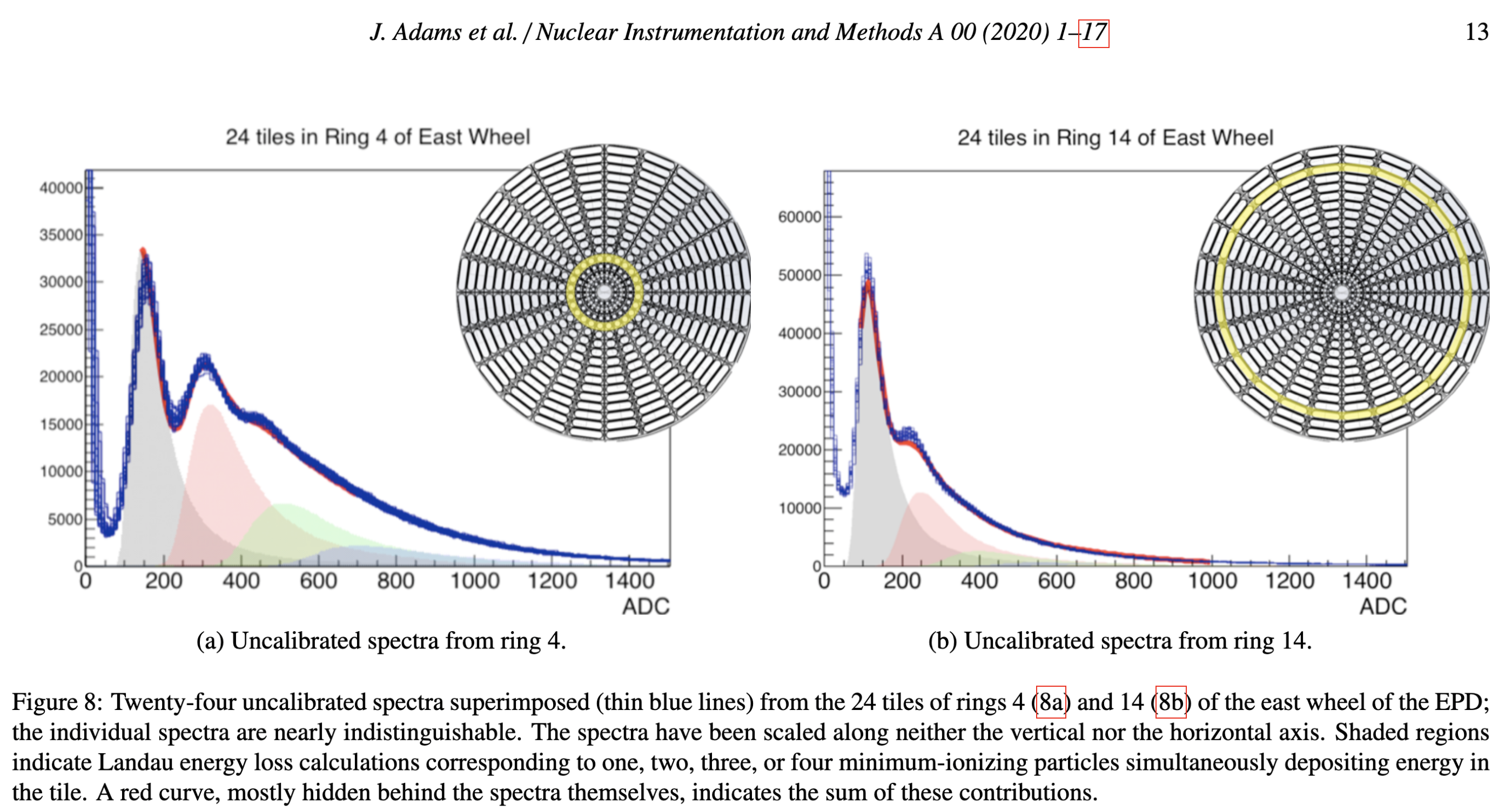
In these spectra, WID/MPV was about 0.14-0.20, according to the paper.
I have described the timing scan extensively (e.g. here). In all cases, a giant pdf file is generated, that shows the evolution of the MPV and WID with gate delay. The goal is to maximize the MPV, but this should also imply a better resolution, i.e. minimized WID/MPV. We generally don't focus on that, but will here.
Here is WID/MPV for Run 19 (March 2018). Runs 19073006-19073015 (Ignore the "periodic" structure of the plots, which is a detail irrelevant here). I'd say WID/MPV minimizes about 0.17 or so.
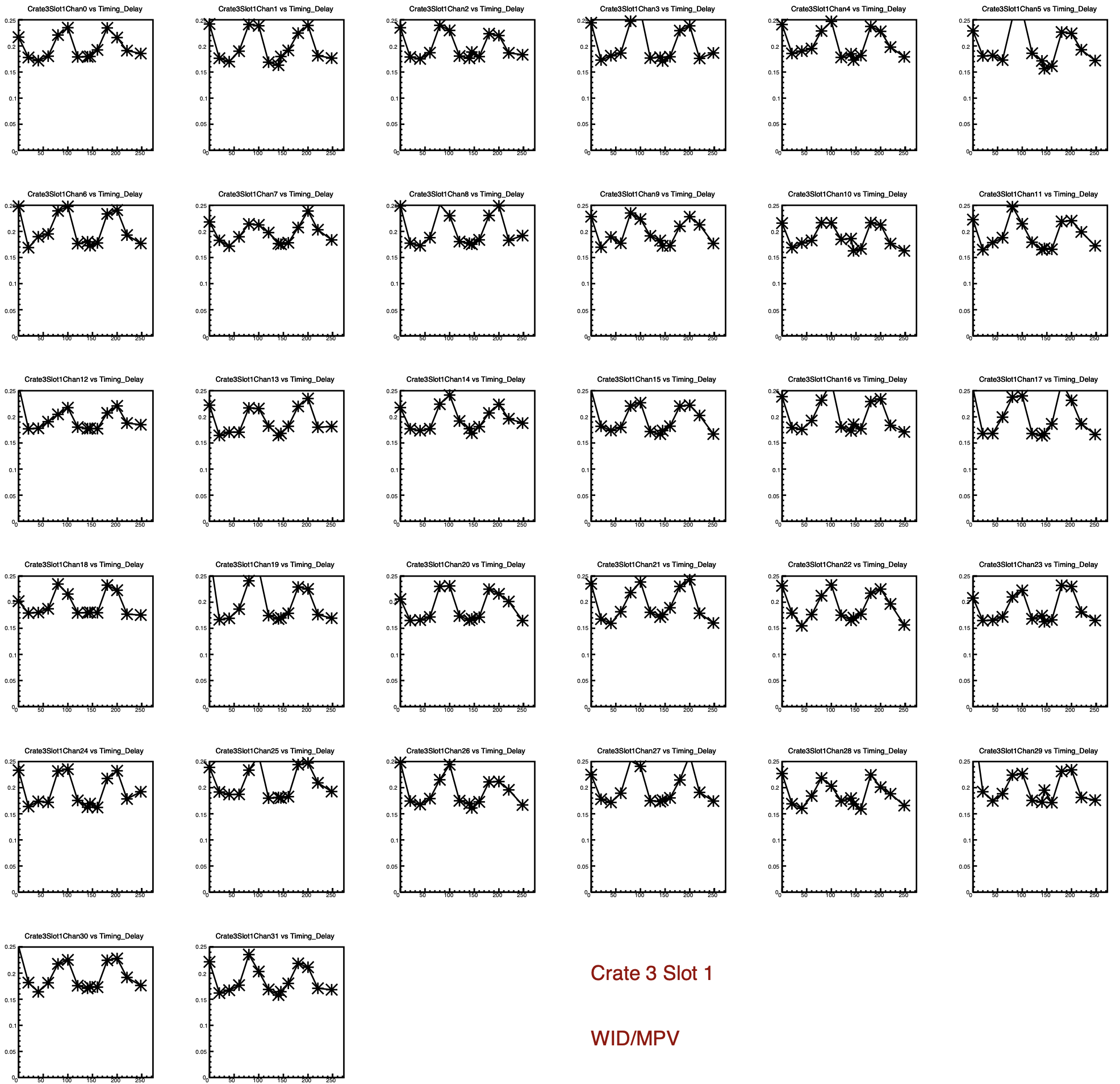
Below is WID/MPV from the timing scan of 2019: (Run 20) Runs 20059002-20059015. It is just for 31 channels, but all tiles look quite similar. Estimating by eyeball, I'd say minimum WID/MPV is about 0.16, i.e not so different than 2018. This is from the very start of the run 20.
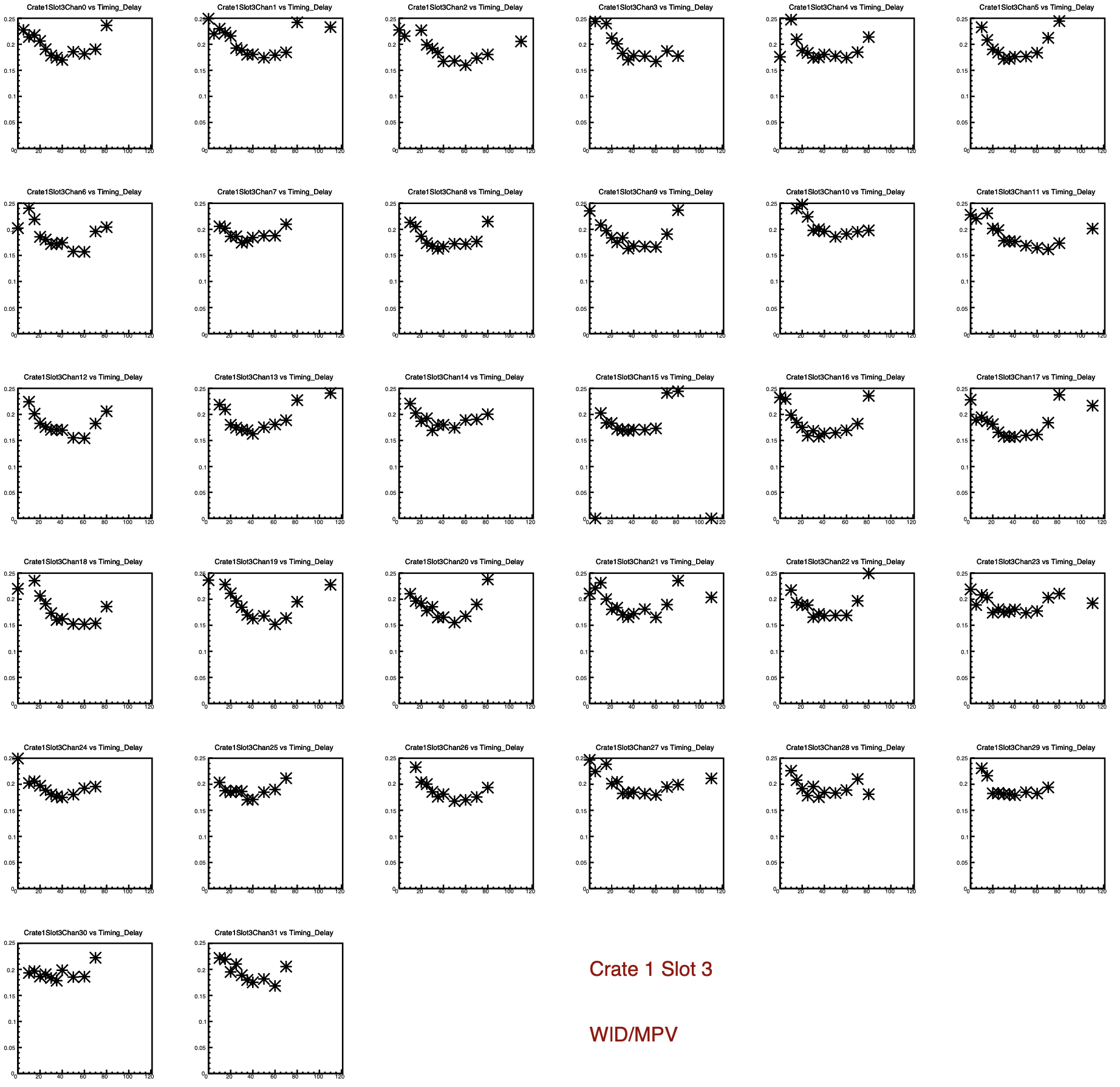
Below is from timing scan of run 23. (December 2021) Runs 22347022-22347032. Again eyeballing, I'll say typical minimum WID/MPV is once again about 0.15 (a bit lower than last year). (We took the scan with lower statistics, so run-to-run fluctuations are higher.)
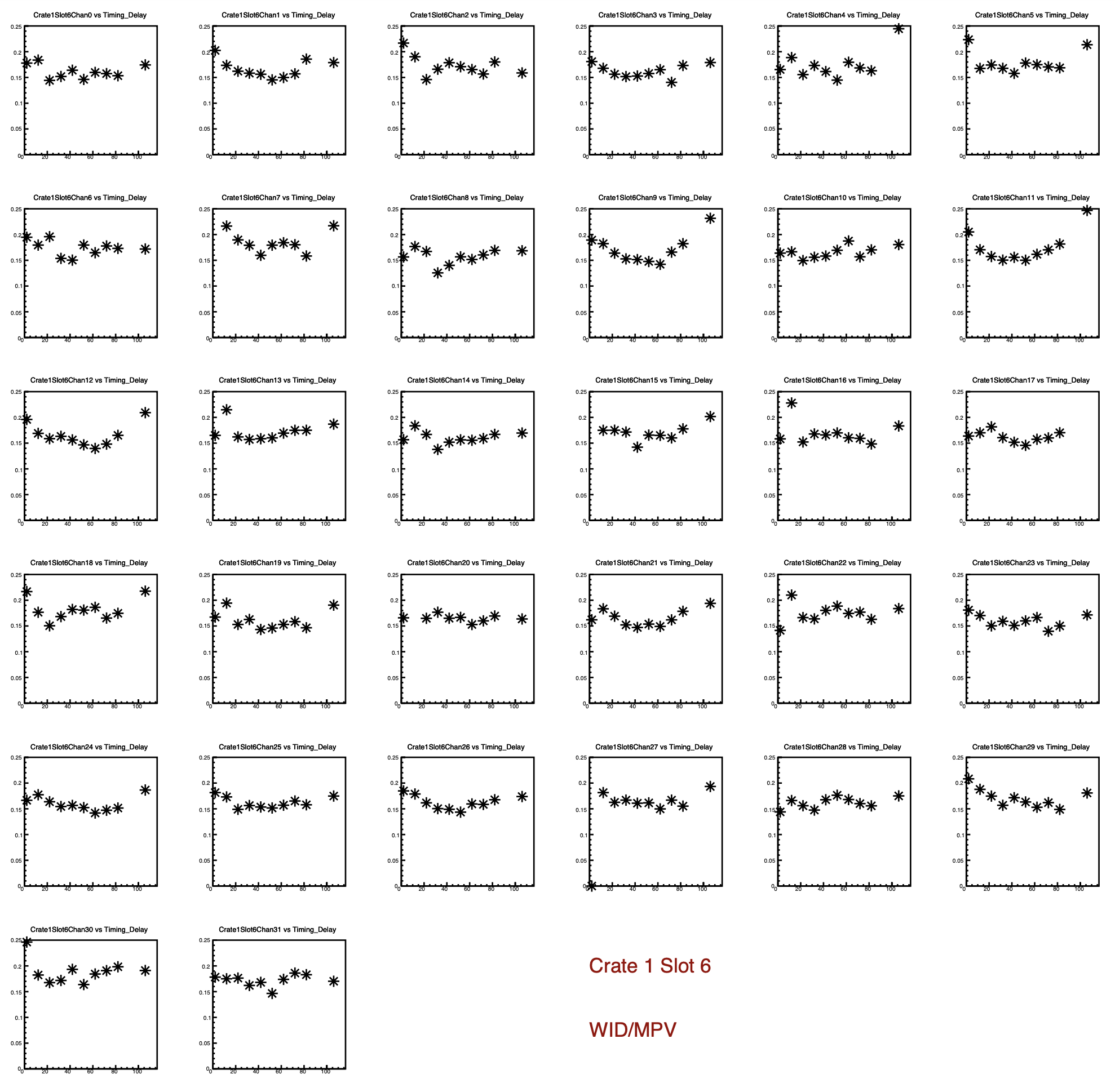
Below is the timing scan of run 24 (May 2023). Runs 24138046-24138056. The WID/MPV is significantly worse ~ 0.2.
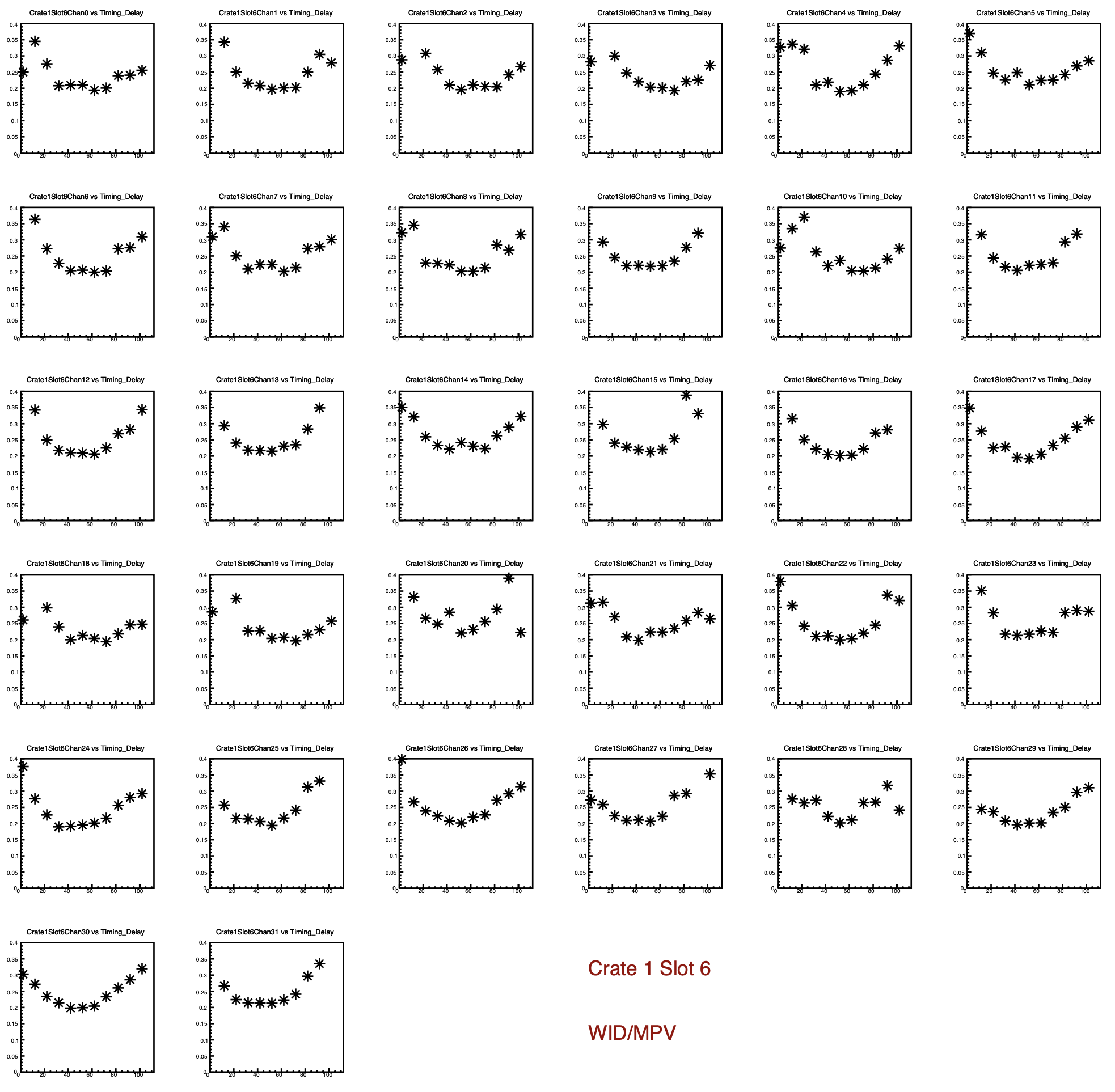
Below is the evolution of the measured MIP peak.
First of all, these are rough estimates of WID/MPV. I could go through and make averages etc. But some trends might be surprising. E.g. run 20059002 is a little better than 19073006, and 22347022 is even better than that! What the heck-- shouldn't performance be getting a bit worse? An answer is that these fits in the timing scan are only one-peak fits. That is, they assume that the distribution is composed solely of one MIP. A full multi-Landau fit with convoluted multi-MIP peaks would take too long and not be worth it. Now, we only fit over a limited range, so it's not so horrible, and anyway this is not a precision measurement, just a timing scan. But what this means is that a high-multiplicity (more to the point, high multiple-hit probability) environment during the scan will artificially increase WID/MPV. And the multi-hit probability is higher for Zr200Zr than for Au19.6Au than for p200p. So that almost certainly explains that.
Now, the most recent scan was taken with Au200Au. That should be even worse than all the rest in terms of multi-hit probability, so that's probably part of the reason WID/MPV is highest now, and even if the SiPMs were as good as they were in run 19073006, we'd expect something a little over WID/MPV=0.17. But okay, let's say 0.17 as a floor. That means the rest comes from the detector and electronics.
There's the possibility that optical coupling has gotten a little worse over the years, and even that the glue has darkened. However, we also know that dark current increased a LOT, so almost certainly SiPM damage contributes to the widening. At the end, the slight increase in broadening from 0.17 to 0.20 is no big deal. We have MIP peaks in all files, and life is good.
I may do a few simple simulations of the effect on (e.g.) EP resolution, if I get around to it. The EPD fast simulator can be used for this.
We will replace the SiPMs at the end of calendar year 2023.
Executive Summary
Silicon multipliers (SiPMs) are damaged by radiation. This increases dark current and noise, broadening a peaked distribution of (e.g.) measured energy loss in a detector.This blog asks whether we see effects of this damage, and whether it is worrisome. Executive summary: yes, we see some broadening. But it is not worrisome at least now.
Introduction
SiPMs for the STAR Forward Calorimeter needed replacement due to radiation. SiPMs for the EPD are mounted at a more shielded location (farther from beam, and behind magnet iron), but still experience damage. Especially the high intensity p+p run in 2022 significantly increased dark currents, as Rosi has shown.Picture and link here.
The energy loss of ionizing radiation in scintillator follows a Landau distribution. This distribution (which interestingly has no well defined mean or variance) is characterized by a peak (Most Probable Value, or MPV) and a width (WID). A well-defined MIP peak has a small WID/MPV. The WID/MPV is more narrow for thicker or denser scintillator. The measured WID/MPV of the electronics signal is increased due to anything that increases fluctuations, like non-perfect photon collection efficiency (or loss in the fibers) and non-perfect photon detection efficiency. It is also increased due to any electronics noise (amplifier, ADC, photomultiplier). In the case of EPD, the electronics noise comes from the SiPM itself.
Therefore, as the SiPM is damaged, we might expect the measured WID/MPV to increase, our MIP peaks to become less well-defined-- if this effect is large enough, it could even cause the physics capability of the detector to degrade. After all, the event plane is more weighted to the angle where more particles hit, in a given event. If our resolution on the number of hits goes down, then so could our event plane resolution.
The starting point - early run 19 (2018)
When the detector and its electronics were brand-spanking new, the MIP peaks were lovely, as we published in our EPD NIM paper. A figure from that paper is shown below. This was taken early in the run 19.
In these spectra, WID/MPV was about 0.14-0.20, according to the paper.
Subsequent years 2019-2023
Every year, we do timing and bias scans. The timing scan is to show us what gate timing will integrate "all" (or most of) the voltage pulse coming from the SiPM. Incomplete integration is another thing that will increase WID/MPV, i.e. Nmip resolution.I have described the timing scan extensively (e.g. here). In all cases, a giant pdf file is generated, that shows the evolution of the MPV and WID with gate delay. The goal is to maximize the MPV, but this should also imply a better resolution, i.e. minimized WID/MPV. We generally don't focus on that, but will here.
Here is WID/MPV for Run 19 (March 2018). Runs 19073006-19073015 (Ignore the "periodic" structure of the plots, which is a detail irrelevant here). I'd say WID/MPV minimizes about 0.17 or so.

Below is WID/MPV from the timing scan of 2019: (Run 20) Runs 20059002-20059015. It is just for 31 channels, but all tiles look quite similar. Estimating by eyeball, I'd say minimum WID/MPV is about 0.16, i.e not so different than 2018. This is from the very start of the run 20.

Below is from timing scan of run 23. (December 2021) Runs 22347022-22347032. Again eyeballing, I'll say typical minimum WID/MPV is once again about 0.15 (a bit lower than last year). (We took the scan with lower statistics, so run-to-run fluctuations are higher.)

Below is the timing scan of run 24 (May 2023). Runs 24138046-24138056. The WID/MPV is significantly worse ~ 0.2.

Year-by-year Evolution and Discussion
Below is the evolution of the measured MIP peak.
| STAR Run | WID/MPV | Species run | notes |
| NIM paper - spectra from first physics runs | 0.14-0.20 | Au+Au 27 GeV (??) | multi-peak fit |
| Timing scan run 19073006 | ~0.17 | Zr+Zr 200 GeV | |
| Timing scan run 20059002 | ~0.16 | Au+Au 19.6 GeV | |
| Timing scan run 21 (2020) | |||
| Timing scan run 22 (2021) | |||
| Timing scan run 22347022 | ~0.15 | p+p 200 GeV | |
| Timing scan run 24 (2023) run 24138046 | ~0.2 | Au+Au 200 GeV |
First of all, these are rough estimates of WID/MPV. I could go through and make averages etc. But some trends might be surprising. E.g. run 20059002 is a little better than 19073006, and 22347022 is even better than that! What the heck-- shouldn't performance be getting a bit worse? An answer is that these fits in the timing scan are only one-peak fits. That is, they assume that the distribution is composed solely of one MIP. A full multi-Landau fit with convoluted multi-MIP peaks would take too long and not be worth it. Now, we only fit over a limited range, so it's not so horrible, and anyway this is not a precision measurement, just a timing scan. But what this means is that a high-multiplicity (more to the point, high multiple-hit probability) environment during the scan will artificially increase WID/MPV. And the multi-hit probability is higher for Zr200Zr than for Au19.6Au than for p200p. So that almost certainly explains that.
Now, the most recent scan was taken with Au200Au. That should be even worse than all the rest in terms of multi-hit probability, so that's probably part of the reason WID/MPV is highest now, and even if the SiPMs were as good as they were in run 19073006, we'd expect something a little over WID/MPV=0.17. But okay, let's say 0.17 as a floor. That means the rest comes from the detector and electronics.
There's the possibility that optical coupling has gotten a little worse over the years, and even that the glue has darkened. However, we also know that dark current increased a LOT, so almost certainly SiPM damage contributes to the widening. At the end, the slight increase in broadening from 0.17 to 0.20 is no big deal. We have MIP peaks in all files, and life is good.
I may do a few simple simulations of the effect on (e.g.) EP resolution, if I get around to it. The EPD fast simulator can be used for this.
We will replace the SiPMs at the end of calendar year 2023.
»
- lisa's blog
- Login or register to post comments
